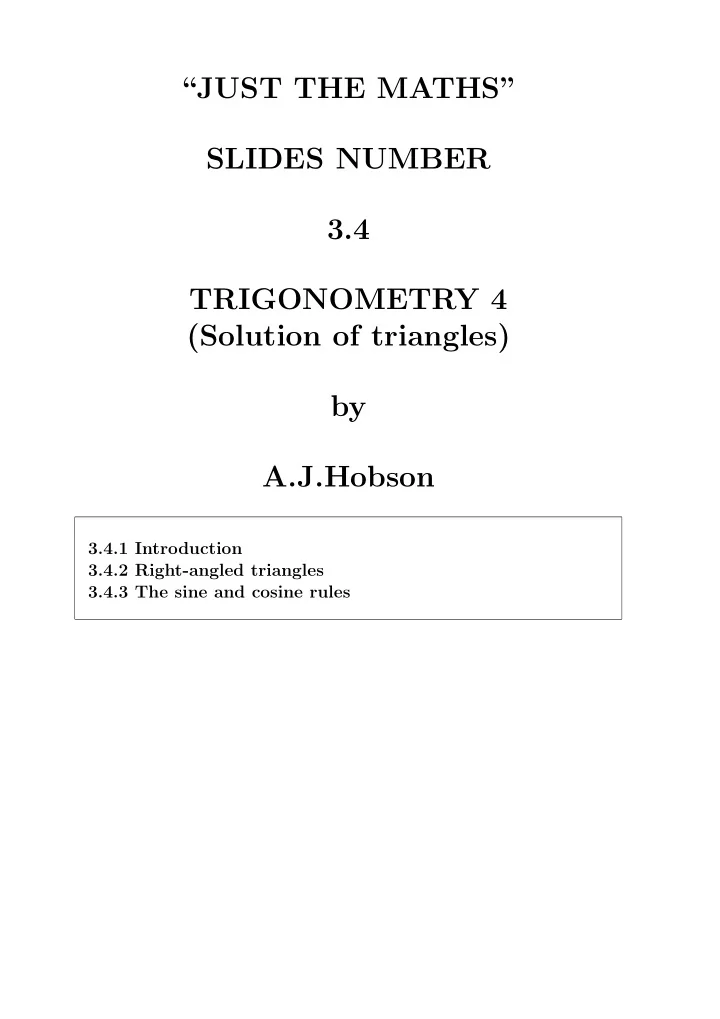

“JUST THE MATHS” SLIDES NUMBER 3.4 TRIGONOMETRY 4 (Solution of triangles) by A.J.Hobson 3.4.1 Introduction 3.4.2 Right-angled triangles 3.4.3 The sine and cosine rules
UNIT 3.4 - TRIGONOMETRY 4 SOLUTION OF TRIANGLES 3.4.1 INTRODUCTION The “solution of a triangle” is defined to mean the complete set of data relating to the lengths of its three sides and the values of its three interior angles. It can be shown that interior angles add up to 180 ◦ . For an arbitrary triangle with “vertices” A,B and C and sides of length a, b and c , we draw C ✟❅ ✟✟✟✟✟✟✟✟✟✟✟✟✟✟✟✟✟✟✟✟✟✟ ❅ ❅ ❅ b a ❅ ❅ ❅ ❅ ❅ ❅ ❅ ❅ A B c � � � The angles at A,B and C will be denoted by B and C . A, 1
3.4.2 RIGHT-ANGLED TRIANGLES EXAMPLE From the top of a vertical pylon, 15 meters high, a guide cable is to be secured into the (horizontal) ground at a distance of 7 meters from the base of the pylon. What will be the length of the cable and what will be its inclination (in degrees) to the horizontal ? Solution ✁ ✁ ✁ ✁ ✁ ✁ ✁ ✁ ✁ ✁ 15m ✁ ✁ ✁ ✁ ✁ ✁ ✁ ✁ ✁ ✁ θ 7m From Pythagoras’ Theorem, the length of the cable will be √ 7 2 + 15 2 ≃ 16 . 55m . 2
The angle of inclination to the horizontal will be θ , where tan θ = 15 and θ ≃ 65 ◦ . 7 3.4.3 THE SINE AND COSINE RULES (a) The Sine Rule a b c A = B = C. � � � sin sin sin (b) The Cosine Rule a 2 = b 2 + c 2 − 2 bc cos � A ; b 2 = c 2 + a 2 − 2 ca cos � B ; c 2 = a 2 + b 2 − 2 ab cos � C. Observation Whenever the angle on the right-hand-side is a right- angle, the Cosine Rule reduces to Pythagoras’ Theorem. 3
The Proof of the Sine Rule First, draw the perpendicular (of length h ) from the ver- tex C onto the side AB. C ✟❅ ✟✟✟✟✟✟✟✟✟✟✟✟✟✟✟✟✟✟✟✟✟✟ ❅ ❅ ❅ b a ❅ ❅ h ❅ ❅ ❅ ❅ ❅ ❅ A B c h A and h � � b = sin a = sin B. � � b sin A = a sin B. b a B = A. � � sin sin The rest of the Sine Rule can be obtained by considering the perpendicular drawn from a different vertex. 4
The Proof of the Cosine Rule Let the side AB have lengths x and c − x either side of the foot of the perpendicular drawn from C. C ✟❅ ✟✟✟✟✟✟✟✟✟✟✟✟✟✟✟✟✟✟✟✟✟✟ ❅ ❅ ❅ b a ❅ ❅ h ❅ ❅ ❅ ❅ x c − x ❅ ❅ A B h 2 = b 2 − x 2 and h 2 = a 2 − ( c − x ) 2 . b 2 − x 2 = a 2 − c 2 + 2 cx − x 2 . a 2 = b 2 + c 2 − 2 xc. � But x = b cos A , and so a 2 = b 2 + c 2 − 2 bc cos � A. 5
EXAMPLES 1. Solve the triangle ABC in the case when B = 30 ◦ and c = 10cm � � A = 20 ◦ , Solution C ✟❅ ✟✟✟✟✟✟✟✟✟✟✟✟✟✟✟✟✟✟✟✟✟✟ ❅ ❅ ❅ b a ❅ ❅ ❅ ❅ ❅ ❅ ❅ ❅ A B c C = 130 ◦ since interior angles add � Firstly, the angle up to 180 ◦ . By the Sine Rule, 10 a b sin 20 ◦ = sin 30 ◦ = sin 130 ◦ ; 10 0 . 342 = b a 0 . 5 = 0 . 766; a = 10 × 0 . 342 ∼ = 4 . 47cm; 0 . 766 b = 10 × 0 . 5 ∼ = 6 . 53cm . 0 . 766 6
2. Solve the triangle ABC in the case when � b = 9cm , c = 5cm and A = 70 ◦ . Solution C ✟❅ ✟✟✟✟✟✟✟✟✟✟✟✟✟✟✟✟✟✟✟✟✟✟ ❅ ❅ ❅ b a ❅ ❅ ❅ ❅ ❅ ❅ ❅ ❅ A B c By the Cosine Rule, a 2 = 25 + 81 − 90 cos 70 ◦ ; a 2 = 106 − 30 . 782 = 75 . 218; a ≃ 8 . 673 ≃ 8 . 67cm . By the Sine Rule, 8 . 673 9 5 sin 70 ◦ = B = C ; � � sin sin B = 9 × sin 70 ◦ = 9 × 0 . 940 � sin ≃ 0 . 975 8 . 673 8 . 673 7
B ≃ 77 . 19 ◦ and � This suggests C ≃ 180 ◦ − 70 ◦ − 77 . 19 ◦ ≃ 32 . 81 ◦ � B ≃ 102 . 81 ◦ and � � Also allow the possibility that C ≃ 7 . 19 ◦ However, alternative solution unacceptable since not consistent with all of the Sine Rule. Thus, � � a ≃ 8 . 67cm , B ≃ 77 . 19 ◦ , C ≃ 32 . 81 ◦ Note: It is possible to encounter examples for which more than one solution does exist. 8
Recommend
More recommend